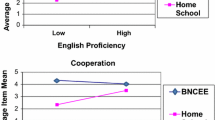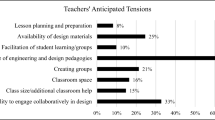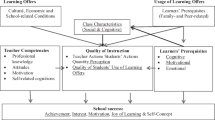Abstract
The purpose of this paper is to describe how and why a primary science methods classroom was conceived, designed, and developed for preservice and inservice teachers. Just as science educators believe that students learn best by constructing their knowledge of the natural world with the aid of a teacher and colleagues, science educators also believe that preservice and inservice teachers should learn in a collaborative and constructivist environment. Multiple dimensions relating to the dynamic processes of learning to teach, a ‘technical factor’ related to the physical and resource constraints that exist within a school, and sociocultural theory were used for the theoretical framework. A survey was given to 97 students who took a course in the classroom, six instructors were given a questionnaire, and three of these instructors were interviewed. These data sources sought to determine the effect of design features on student learning and instructor teaching. The results of the evaluation suggest students who used the classroom found their learning positively affected by the room design and instructors who taught in the classroom benefited by being able to teach in an inquiry and constructivist manner.
Similar content being viewed by others
References
Biehle, J.T., Motz, L.L. & West, S.S. (1999). NSTA guide to school science facilities. Arlington, Virginia: National Science Teachers Association.
Bourdieu, P. (1984). Distinction: A social critique of the judgment of taste. Translated by Richard Nice. Cambridge, Massachusetts: Harvard University Press.
Calderhead, J. & Shorrock, S.B. (1997). Understanding teacher education. Washington, DC: The Falmer Press.
Cobern, W.W. (1993). World view, metaphysics, and epistemology. Scientific literacy and cultural studies project, working paper no. 106. Paper presented at the annual meeting of the National Association for Research in Science Teaching (Atlanta, GA). Available ED361204.
Cobern, W.W. (1996). Worldview theory and conceptual change in science education. Science Education, 80(5), 579–610.
D’Andrade, R. & Strauss, C. (Eds.) (1992). Human motives and cultural models. Cambridge, England: Cambridge University Press.
Driedger, S.M., Eyles, J., Elliott, S.D. & Cole, D. (2002). Constructing scientific authorities: Issue framing of chlorinated disinfection byproducts in public health. Risk Analysis, 22(4), 789–802.
Forman, E.A. & McCormick, D.A. (1995). Discourse analysis: A sociocultural perspective. Remedial and Special Education, 16(3), 150–158.
Fraser, B.J. (1986). Classroom environment. London: Croom Helm.
Fraser, B.J. & O’Brien, P. (1985). Student and teacher preparation of the environment of primary classrooms. Elementary School Journal, 85(5), 567–580.
Fraser, B.J. & Treagust, D.F. (1986). Validation and application of the college and university classroom environment inventory (CUCEI). Paper presented at the annual meeting of the American Educational Research Association, San Francisco, April.
Gee, J.P. (1990). Social linguistics and literacies: Ideology in discourses. London: Falmer.
Gee, J.P. (1996). Language, individuals, and discourses. In Social linguistics and literacies: Ideology in discourses (pp. 181–191). London: Falmer.
Hepburn, G. & Gaskell, P.J. (1998). Teaching a new science and technology course: A sociocultural perspective. Journal of Research in Science Teaching, 35, 777–789.
Hine, P. & Fraser, B.J. (2002). Classroom environment and the transition to secondary schooling.
Hodson, D. (1999). Building a case for a sociocultural and inquiry-oriented view of science education. Journal of Science Education and Technology, 8, 241–249.
Jones, M.G., Carter, G. & Rua, M.J. (2000). Exploring the development of conceptual ecologies: Communities of concepts related to convection and heat. Journal of Research in Science Teaching, 37(2), 139–159.
Lee, C.C. (1998). Assessing diverse populations. Paper presented at the ERIC Clearinghouse on Counseling and Student Services Conference: “Assessment ’98: Assessment for Change – Changes in Assessment” (St. Petersburg, FL). Available ED426330.
Lewis, A.C. (1997). School facilities fit for reform. In National Education Knowledge Industry Association Communications (Ed.), PROBE: Developing education policy issues (pp. 31–37). Washington, DC: National Education Knowledge Industry Association Communications.
Martin, D.J. (2000). Elementary science methods: A constructivist approach. Wadsworth, USA: Thomas Learning.
National Research Council (1996). National science education standards. Washington DC: National Academy Press.
North Carolina Department of Public Instruction (2002). School science facilities planner. Raleigh, North Carolina: Author.
Shepardson, D.P. (1999). Learning science in a first grade science activity: A Vygotskian perspective. Science Education, 83(5), 621–638.
Taylor, P., Dawson, V. & Fraser, B. (1995, April) Classroom learning environments under transformation: A constructivist perspective. Paper presented at the annual meeting of the American Educational Research Association, San Francisco, CA.
Uhlenbeck, V., Verloop, N. & Beijaard, D. (2002). Requirements for an assessment procedure for beginning teachers: Implications from recent theories on teaching and assessment. Teachers College Board, 104(2), 242–272.
Zandvliet, D. & Fraser, B. (1999, March). A model of education productivity for high school internet classrooms. Paper presented at the annual meeting of the American Educational Research Association, Montreal, Canada.
Author information
Authors and Affiliations
Corresponding author
Rights and permissions
About this article
Cite this article
Veal, W.R., Jackson, Z. Developing a Primary Science Methods Classroom. Int J Sci Math Educ 4, 195–213 (2006). https://doi.org/10.1007/s10763-005-9000-0
Received:
Accepted:
Published:
Issue Date:
DOI: https://doi.org/10.1007/s10763-005-9000-0




